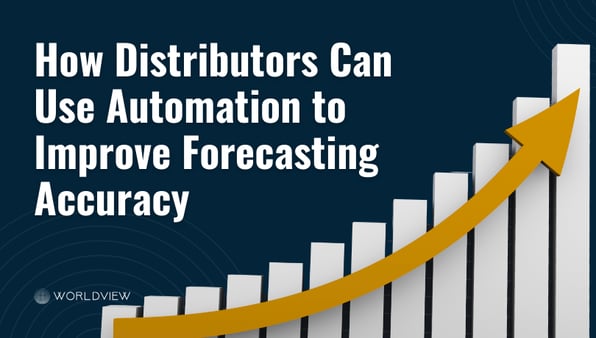How Distributors Can Use Automation to Improve Forecasting Accuracy

Excelling in demand forecasting can transform you into the preferred building materials distributor. Inventory forecasting helps you meet customer needs cost-effectively.
Demand forecasting can be tricky, but having the right tools at your disposal will produce accurate information. Your manual spreadsheets and piles of historical data will become obsolete when you use demand planning automation that gives you precise findings.
Why Forecasting Is Hard in Distribution
Unlike stable, predictable industries such as grocery retail, the building materials market is constantly fluctuating. Demand in your industry is seasonal and driven by specific projects. Changing regulations, customer preferences, seasonal needs, and cost fluctuations can quickly impact demand for certain products.
Relying on manual spreadsheets makes it harder to keep up with constant market changes. As you and your team consolidate and analyze data from multiple sources, the market may be shifting in a way that renders your forecast outdated and inaccurate.
The Data Problem
An accurate demand forecast stems from sales data, inventory information, and accounting systems. You may also supplement internal data with industry-wide information from trade publications and other sources.
Reconciling all this data manually takes time. Your team needs to gather reports from every department and enter them into a single spreadsheet. If your teams aren’t formatting information the same way, they have to standardize all the data before they can analyze it.
This process is prone to human error, increasing the chances of forecast inaccuracy.
Connecting Systems With Automation
If your enterprise resource planning (ERP), customer relationship management (CRM), and finance tools aren’t integrated already, consider that your first step toward automation. An integrated system breaks down data silos.
Connected systems serve as a single source of truth. Everyone in your organization is working with the same information. When it’s time to consolidate data to create a demand forecast, you know your team has updated, accurate information.
For example, if you’re not using an enterprise content management system with version control, someone can update a report and save it to their computer. The file on your server becomes outdated, but there’s no way to know unless the person who updated the report shares it.
Integrated systems let you easily compare historical data with real-time inventory, sales data, and other insights impacting demand.
Using Real-Time Reporting
Real-time reporting also alerts leadership to market shifts impacting your business. For example, say a large company sets up shop in the same city as your best customers. The influx of new jobs creates a housing boom. Your customers may start ordering building materials in bulk, and you see a spike in demand.
Your dashboard would show these order spikes, and you can instantly plan your inventory to meet increased demand in one location without draining your inventory. Dashboards also highlight price spikes, supply chain disruptions, and other factors impacting your business.
Predictive Tools for Planning
Many demand planning automation solutions use artificial intelligence to analyze data. These tools use machine learning to assess your historical data and identify patterns and trends. An AI-powered demand forecasting tool can evaluate a pile of data in seconds.
Think how long it would take for you and your team to manually enter and analyze 10 years of historical sales data. AI can comb through this information and generate valuable insights that help you plan your inventory.
Pair your internal data with industry reports and other external sources for complex forecasts. Since AI assesses more data, your demand forecasts are usually more accurate. Leadership can use these insights to plan inventory levels and adjust staff based on demand. You can stock proactively for a demand spike without carrying excess inventory in your warehouse for months.
From Reactive to Proactive
Instead of operating as usual until the supply chain is disrupted, demand planning automation lets you plan ahead. Under your current operating model, you may order materials as needed based on customer orders.
Just-in-time inventory increases your risk of stockouts. You either have to pay more to restock your inventory on the fly, or you miss out on a sale. Demand forecasting helps you plan based on market trends, economic indicators, historical data, and other information. You can learn to anticipate supply chain disruptions before they happen and put contingency plans in place to keep your business running smoothly.
Future-Proofing With Forecasting
Stop relying on limited datasets to make your demand forecasts. Automating your demand forecasting with connected systems and AI makes your business more flexible and resilient. You can adapt to market shifts faster and maintain customer expectations.
Forecast accuracy helps you stay competitive even as supply chain conditions shift. Explore WorldView Commerce forecasting solutions to make your business more agile. Our solutions offer financial systems integration and connect with other systems for faster data analysis.
Contact us today to learn more.
Get Awesome Content Delivered Straight to Your Inbox!
Posts by topic
- Healthcare
- Business
- AI
- Hospice
- AP Workflows
- Home Care Management
- hospice-care
- General
- Industry Insights
- agency
- Blog
- Commercial
- reporting
- Data Analytics
- billing
- referrals
- News
- Referral AI
- business goals
- Operations
- business development
- partners
- Integration
- Healthcare Trends
- leadership
- Medicare
- Compliance
- audit
- medicaid
- Better Charting
- regulations
- Application
- Automation
- finance
- CRM
- DMSi
- Events
- KanTime
- Press Release
- Revenue Growth
- Announcements
- Artificial Intelligence
- EHR
- ESign
- Guides
- Homecare Homebase
- Mobile
- Physician Order Tracking
- axxess
- clinical
- interoperability
- payor See All See Less


.png?width=596&name=WV%20Hc%20Clinical%201%20Web%20(3).png)
.png?width=596&name=WV%20Hc%20Clinical%201%20Web%20(2).png)
.png?width=596&name=WV%20Hc%20Clinical%201%20Web%20(5).png)